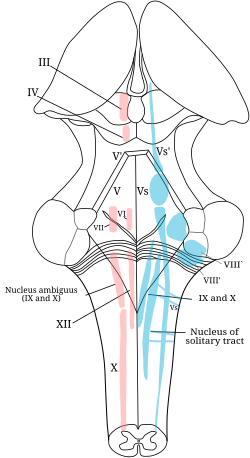| Solitary nucleus | |
|---|---|
 The cranial nerve nuclei schematically represented; dorsal view. Motor nuclei in red; sensory in blue. | |
 Transverse section of medulla oblongata of human embryo. | |
| Details | |
| Identifiers | |
| Latin | nucleus tractus solitarii medullae oblongatae |
| MeSH | D017552 |
| NeuroNames | 742 |
| NeuroLex ID | birnlex_1429 |
| TA98 | A14.1.04.230 |
| TA2 | 6008 |
| FMA | 72242 |
| Anatomical terms of neuroanatomy | |
The solitary nucleus (SN) (nucleus of the solitary tract, nucleus solitarius, or nucleus tractus solitarii) is a series of neurons whose cell bodies form a roughly vertical column of grey matter in the medulla oblongata of the brainstem. Their axons form the bulk of the enclosed solitary tract. The solitary nucleus can be divided into different parts including dorsomedial, dorsolateral, and ventrolateral subnuclei.[1]
The solitary nucleus receives general visceral and special visceral inputs from the facial nerve (CN VII), glossopharyngeal nerve (CN IX) and vagus nerve (CN X); it receives and relays stimuli related to taste and visceral sensation. It sends outputs to various parts of the brain, such as the hypothalamus, thalamus, and reticular formation, forming circuits that contribute to autonomic regulation.
Cells along the length of the SN are arranged roughly in accordance with function; for instance, cells involved in taste are located in the rostral part, while those receiving information from cardio-respiratory and gastrointestinal processes are found in the caudal part.[2][3] The cells involved in taste are the part of the solitary nucleus referred to as the gustatory nucleus.[4]
- ^ Carpenter, Malcolm B. (1985). Core text of neuroanatomy (3rd ed.). Baltimore: Williams & Wilkins. pp. 124–125. ISBN 0683014552.
- ^ Haines, Duane (2018). Fundamental neuroscience for basic and clinical applications (Fifth ed.). Philadelphia, PA: Elsevier. p. 201. ISBN 9780323396325.
- ^ P. Michael Conn (2008). Neuroscience in Medicine. Springer. p. 264. ISBN 978-1-60327-455-5. Retrieved 22 January 2013.
- ^ Carpenter, Malcolm Breckenridge (1985). Core text of neuroanatomy (3. ed.). Baltimore: Williams & Wilkins. p. 151. ISBN 0683014552.